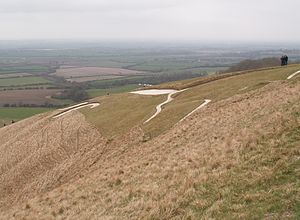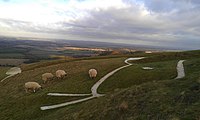White Horse of Uffington

The White Horse of Uffington is a large, prehistoric hill figure inscribed upon the scarp slope of White Horse Hill in Berkshire. Fully 375 feet long, the figure is a highly stylized horse visible for many miles around, formed from deep trenches filled with crushed white chalk.
The figure is found on the upper slopes of the hill in the parish of Uffington in Berkshire. It is about eight miles south of the town of Faringdon and a similar distance west of the town of Wantage, and a mile and a half south of Uffington.
Best views of the figure are obtained from the air, or from directly across the Vale, particularly around the villages of Great Coxwell, Longcot and Fernham. The site is owned and managed by the National Trust and is a Scheduled Ancient Monument.[1]
White Horse Hill
| Whitehorse Hill | |||
| Berkshire | |||
|---|---|---|---|
 White Horse Hill | |||
| Range: | Berkshire Downs | ||
| Summit: | 86 feet SU301866 51°34’39"N, 1°34’1"W | ||
White Horse Hill forms a part of the scarp of the Berkshire Downs and overlooks the Vale of White Horse to the north.
The hill is used by the local Paragliding and Hang Gliding Club.
History
The figure presumably dates to "the later prehistory", which is to say the Iron Age (800 BC–AD 100) or the late Bronze Age (1000–700 BC). This view was generally held by scholars even before the 1990s, based on the similarity of the horse's design to comparable figures in Celtic art, and it was confirmed following a 1990 excavation led by Simon Palmer and David Miles of the Oxford Archaeological Unit, following which deposits of fine silt removed from the horse's 'beak' were scientifically dated to the late Bronze Age.[2]
Iron Age coins that bear a representation comparable to the Uffington White Horse have been found, supporting the early dating of this artifact; it has also been suggested that the horse had been fashioned in the Anglo-Saxon period, more particularly during Alfred's reign, but there is no positive evidence to support this and the view is classified as "folklore" by Darvill (1996).

Numerous other prominent prehistoric sites are located nearby, notably Wayland's Smithy, a long barrow just over a mile to the west. The Uffington horse is by far the oldest of the white horse figures in Britain, and is of an entirely different design from the others.[3]
It has long been debated whether the chalk figure was intended to represent a horse or some other animal. However, it has been called a horse since the 11th century at least. A cartulary of Abingdon Abbey, compiled between 1072 and 1084, refers to "mons albi equi" at Uffington ("the White Horse Hill").[4]

The mediæval Welsh book, Llyfr Coch Hergest [The Red Book of Hergest], circa 1400, states "Gerllaw tref Abinton y mae mynydd ac eilun march arno a gwyn ydiw. Ni thyf dim arno." which translates as "Near to the town of Abinton [Abingdon] there is a mountain with a figure of a stallion upon it and it is white. Nothing grows upon it." [5]
The horse is thought by some to represent a tribal symbol perhaps connected with the builders of Uffington Castle.
The horse is quite similar to horses depicted on Celtic coinage, the currency of the indigenous, pre-Roman-British population, and the Marlborough bucket.
Until the late 19th century the horse was scoured every seven years as part of a more general local fair held on the hill. When regular cleaning is halted the figure quickly becomes obscured; it has always needed frequent work for the figure to remain visible.
In August 2002 the figure was defaced with the addition of a rider and three dogs an act claimed by the "Real Countryside Alliance", and denounced by the actual Countryside Alliance.[6]
In March 2012, as part of a pre-Cheltenham Festival publicity stunt, a bookmaker added a large jockey to the figure.[7]
The Folkestone White Horse in Kent, is based on this horse.
Nearby features and recent events


The most significant nearby feature is the Iron Age Uffington Castle, on higher ground atop a knoll above the White Horse.[8] This hillfort comprises an area of approximately seven acres enclosed by a single, well-preserved bank and ditch. Dragon Hill is a natural chalk hill with an artificial flat top, associated in legend with St George.[9]
Whitehorse Hill is designated a Site of Special Scientific Interest (SSSI). It is a geological SSSI due to its Pleistocene sediments, and a biological SSSI as it has one of the few remaining unploughed grasslands along the chalk escarpment in Berkshire.[10][11]

To the west are ice-cut terraces known as the "Giant's Stair".[12] Some believe these terraces at the bottom of this valley are the result of mediæval farming, or alternatively were used for early farming after being formed by natural processes. The steep sided dry valley below the horse is known as the Manger and legend says that the horse grazes there at night.

The Blowing Stone, a perforated sarsen stone, which lies in a garden in Kingston Lisle, two kilometres away and which produces a musical tone when blown through, is thought possibly to have been moved from the White Horse site, in 1750.
In popular culture
- Richard Doyle, a cartoonist and illustrator, illustrated the 1859 book The Scouring of the White Horse by Thomas Hughes, the author of Tom Brown's Schooldays. The book mentions both the horse and the Blowing Stone.
- G. K. Chesterton's poem The Ballad of the White Horse, published in 1911, gives a Christian interpretation to the continual scouring needed to maintain the impression in the chalk over the intervening millennia. This is achieved in the context of a romantic retro-mediæval depiction of the exploits of King Alfred the Great.
- Rosemary Sutcliff's 1977 children's book Sun Horse, Moon Horse tells the story of the creator of the figure.
- David Bedford's Song of the White Horse (1978), commissioned for the BBC's Omnibus programme, depicts a journey along a footpath alongside the Uffington Horse and includes words from Chesterton's poem. At the climax of the video, aerial footage of the horse has been animated to show it rearing up from the ground.[13][14]
- The 1978 BBC television children's series The Moon Stallion uses the chalk horse as one of its principal locations and a major plot element, and includes footage of it in the title sequence.
- The Uffington Horse is illustrated on the cover of English Settlement (1982), the fifth studio album by the Swindon band XTC.
- Clive Cussler refers to the Uffington Horse in his 2003 novel Trojan Odyssey, where it is the symbol of the cult presided over by Epona Eliade.
- In Terry Pratchett's Discworld novel A Hat Full of Sky (2004) a White Horse based on this one is a prominent geographical feature in the Chalk region ("Taint what a horse looks like, it's what a horse be.")
- Both Uffington White Horse and the Wayland's Smithy are featured in the 2008 mystery novel "A Pale Horse" by Charles Todd
- The Uffington Horse is the symbol of Wessex Hall at the University of Reading, adopted in 1920 and still in use today.
- Faringdon Community College and Faringdon Infant School in Faringdon, Berkshire, use the White Horse as their logo.
- The horse is the emblem of the Berkshire Yeomanry, a Territorial Army unit based in Windsor, Reading and Chertsey.
- The Uffington White Horse is often presented as an image of Epona in popular works on Neopaganism.
- Michael O'Brien's first chapter in Strangers and Sojourners (Ignatius Press, 1997) opens with a neopagan ritual in 1900 conducted near the horse. Apparently, the Theosophist Annie Besant is present as a close friend of the main character's family. The leader of the ritual harkens to a pre- and post-Christian Britain.
See also
Outside links
| ("Wikimedia Commons" has material about White Horse of Uffington) |
- The National Trust - White Horse Hill
- Ancient Britain - The White Horse
- Uffington Whitehorse and Dragon Hill (Mysterious Britain & Ireland)
- Aerial photos and information
- Wiltshire and Oxfordshire chalk horses
- Royal Berkshire History: The Uffington White Horse
- The White Horse of Uffington
Notes
- ↑ National Heritage List 1008413: The White Horse hill figure 170m NNE of Uffington Castle on Whitehorse Hill
- ↑ Darvill, Prehistoric Britain from the Air (1996), p. 223.
- ↑ "Wiltshire Uffington". Wiltshirewhitehorses.org.uk. 2010-03-21. http://wiltshirewhitehorses.org.uk/uffington.html. Retrieved 2011-04-23.
- ↑ Plenderleath, Rev. W. C., The White Horses of the West of England (London: Allen & Storr, 1892), page 8
- ↑ http://www.maryjones.us/ctexts/hindex.html
- ↑ "White horses defaced by activists". BBC News. 2002-08-28. http://news.bbc.co.uk/1/hi/england/2220725.stm. Retrieved 2011-04-23.
- ↑ "Bookmaker adds jockey to Uffington Horse" BBC News 8 March 2012
- ↑ British Archaeology, Editor: Simon Denison, Issue no 33, April 1998 ISSN 1357-4442
- ↑ "Uffington Castle - White Horse and Dragon Hill". English Heritage. 2011-04-16. http://www.english-heritage.org.uk/daysout/properties/uffington-castle-white-horse-and-dragon-hill/. Retrieved 2011-04-23.
- ↑ "Whitehorse Hill citation". Natural England. http://www.sssi.naturalengland.org.uk/citation/citation_photo/1001206.pdf. Retrieved 23 December 2013.
- ↑ "Map of Whitehorse Hill". Natural England. http://magic.defra.gov.uk/MagicMap.aspx?startTopic=Designations&activelayer=sssiIndex&query=HYPERLINK%3D%271001206%27. Retrieved 23 December 2013.
- ↑ "Royal Berkshire History: The Uffington White Horse". Berkshirehistory.com. http://www.berkshirehistory.com/archaeology/white_horse.html. Retrieved 2011-04-23.
- ↑ Song of the White Horse (David Bedford, 1978) YouTube, posted by family of David Bedford
- ↑ David Bedford's The Song of the White Horse BBC Radio 3
Sources and further reading
- Darvill, Timothy (1996). Prehistoric Britain from the Air: A study of space, time and society. Cambridge: Cambridge University Press. ISBN 0-521-55132-3. http://books.google.co.uk/books?id=ZPC_Bd7reVcC&pg=PA222.
- Dyer, J (2001). Discovering Prehistoric England. Oxford: Shire Books. ISBN 0-7478-0507-5.
- Miles, David; Palmer, Simon; Lock, Gary; Gosden, Chris; Cromarty, Anne Marie (2003). Uffington White Horse and its Landscape: Investigations at White Horse Hill, Uffington, 1989–95 and Tower Hill, Ashbury, 1993–4. Thames Valley Landscape Series. 18. Oxford: Oxford University School of Archaeology. ISBN 0-947816-77-1.
- Plenderleath, Rev. W.C (1892). The White Horses of the West of England. London: Allen & Storr.
